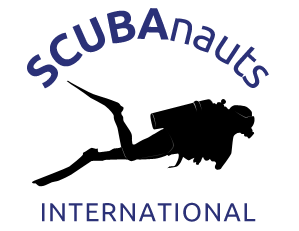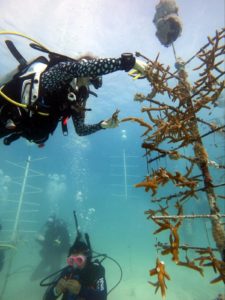In November, a group of ten nauts traveled from around Florida to Summerland Key for four days of diving– or at least of adventures! For our first day in the Keys, we spent the morning studying organism identifications.
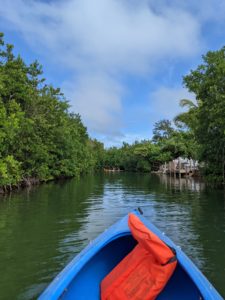
Kayaking through the Keys, nauts mentored each other on mangrove identification as well as paddling techniques.
We were divided into two groups, one group did a briefing on fish and the other did benthic. I was in the benthic group where Sierra, another Naut, gave a lesson to our group. In the benthic group, we practiced identifying the different types of coral, algae, and invertebrates found on the reef. After our morning science lesson, the Nauts went for a kayaking and paddle boarding session. We paddled to the mangroves and identified the bunch as red mangroves, using the moniker “red, red, pointy head!” which helps to remember the shape of the leaves.
Joint Dives with Other Youth
The next day, we met up with another youth diving group, DiveN2Life, at the Looe Key Reef Resort and Dive Center where we worked on our skills in the pool. We learned a new skill which was how to make two different knots: Reef and Bowline Knot. We then put our knotting skills to the test by practicing how to tie a lift bag and send it up. We also worked on our buoyancy as we were challenged to use wrenches underwater to take nuts off of a cement block without hitting the bottom. We then packed up and invited DiveN2Life to join us for dinner where they worked on their CPR training.
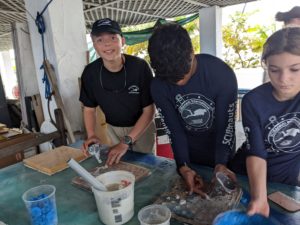
Coral restoration researcher Dr. David Vaughn shows nauts how to build concrete pieces used in fragment outplanting.
The following morning, we started the day off with a bang and kayaked across the canal to visit a scientist who discovered Micro Fragmentation in 2006. Basically you take a piece of coral the size of a golf ball and cut it up into 100 small pieces causing it to grow at a rate where 3 years of growth takes only 3 weeks. Since discovering this process, Dr. Vaughn created a program called “Plant A Million Corals” with the goal being just like the name, planting a million corals to show that coral restoration can be done. We helped him to make cement plugs for the coral to be put on. He also gave us useful life tips and amazing facts. Overall it was a great experience. Later that day we met up with DiveN2Life and did a dive to 60 feet and found some fishing line. Then we went to a shallower depth of about 20 feet and found a big metal tree looking thing and a bunch of wood. This day was definitely one of the best!
Coral Restoration
On Sunday, we had a guest speaker come in. Samantha Simpson from Mote Marine Lab talked about fragging corals and using monofilament lines,
or mono, to attach corals to the coral tree. This was to teach us these skills to help us do it underwater. After we learned these skills, we went diving in Mote’s Coral Nursery. There were 3-4 people working on 1 tree to fill. The people who were fragging cut pieces of the coral that was grown enough where it could be cut. One of the biggest challenges of fragging the coral is you have to be aware of the fire coral on the branches. Fire coral is itchy when you touch it and was very irritating. The second job for the coral restoration project was tying the monos around the coral ready for the hangers to hang it. The final job was tying the monos with the coral on the new tree.
Even after three long, working dives, we had more work to do! To end off the night, we did our dive logs and worked on various tasks in the classroom. We completed some of our AAUS academic training, which was dive tables this night. While some people did the dive tables, Sierra did data entries and Hayden and Hatcher did nitrox training. After this we settled down into our dorms and ended our night with dessert.
Dive Training to Support Research
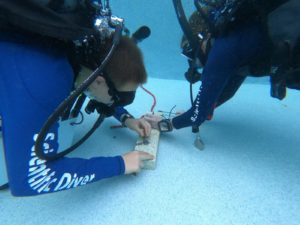
Divers practice fine motor skill tasks in teams to prepare for open water research tasks like coral restoration and benthic surveys.
On our last day at the MOTE Marine lab, we received a tour of the facilities from Zach from the Coral Restoration Lab. He showed us where all the new coral recruits are growing, as well as the larger corals ready to be out planted. We learned how difficult and tedious keeping corals can be as constant cleaning and monitoring is necessary to ensure the best results. Also, since corals can take years to grow to maturity, one mistake can be very costly. After that, we dove in Horseshoe Bay to work on our search and recovery skills. This was perfect since the visibility in ‘The Shoe’ did not improve past 5 feet. We learned different patterns for searching in low visibility conditions, such as the expanding square, expanding circle, and U-Pattern. It was a lot of fun and diving in the poor conditions really prepares us for future science dives. Visibility and current will not always be perfect on the reef or in a nursery, so why should it be during training? All in all, our last day at Mote was great as always!
— By: Sage M., 2nd Class Naut, Tarpon Springs; John Humphreys, Naut-in-Training, Tampa; Anya Amin, Naut-in-Training, Orlando; Hayden Ramsey, 2nd Class Naut, Orlando
